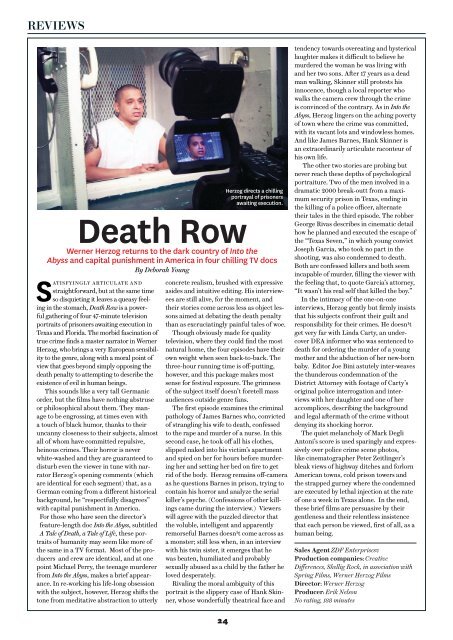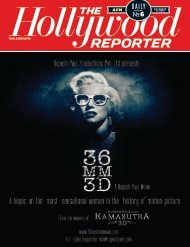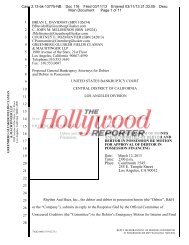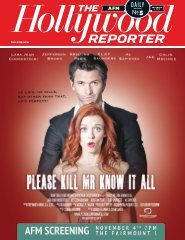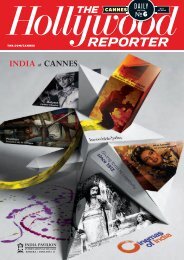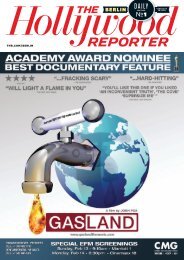Berlin Day 2 - The Hollywood Reporter
Berlin Day 2 - The Hollywood Reporter
Berlin Day 2 - The Hollywood Reporter
You also want an ePaper? Increase the reach of your titles
YUMPU automatically turns print PDFs into web optimized ePapers that Google loves.
Reviews<br />
Death Row<br />
Werner Herzog returns to the dark country of Into the<br />
Abyss and capital punishment in America in four chilling TV docs<br />
By Deborah Young<br />
Satisfyingly articulate and<br />
straightforward, but at the same time<br />
so disquieting it leaves a queasy feeling<br />
in the stomach, Death Row is a powerful<br />
gathering of four 47-minute television<br />
portraits of prisoners awaiting execution in<br />
Texas and Florida. <strong>The</strong> morbid fascination of<br />
true crime finds a master narrator in Werner<br />
Herzog, who brings a very European sensibility<br />
to the genre, along with a moral point of<br />
view that goes beyond simply opposing the<br />
death penalty to attempting to describe the<br />
existence of evil in human beings.<br />
This sounds like a very tall Germanic<br />
order, but the films have nothing abstruse<br />
or philosophical about them. <strong>The</strong>y manage<br />
to be engrossing, at times even with<br />
a touch of black humor, thanks to their<br />
uncanny closeness to their subjects, almost<br />
all of whom have committed repulsive,<br />
heinous crimes. <strong>The</strong>ir horror is never<br />
white-washed and they are guaranteed to<br />
disturb even the viewer in tune with narrator<br />
Herzog’s opening comments (which<br />
are identical for each segment) that, as a<br />
German coming from a different historical<br />
background, he “respectfully disagrees”<br />
with capital punishment in America.<br />
For those who have seen the director’s<br />
feature-length doc Into the Abyss, subtitled<br />
A Tale of Death, a Tale of Life, these portraits<br />
of humanity may seem like more of<br />
the same in a TV format. Most of the producers<br />
and crew are identical, and at one<br />
point Michael Perry, the teenage murderer<br />
from Into the Abyss, makes a brief appearance.<br />
In re-working his life-long obsession<br />
with the subject, however, Herzog shifts the<br />
tone from meditative abstraction to utterly<br />
concrete realism, brushed with expressive<br />
asides and intuitive editing. His interviewees<br />
are still alive, for the moment, and<br />
their stories come across less as object lessons<br />
aimed at debating the death penalty<br />
than as excruciatingly painful tales of woe.<br />
Though obviously made for quality<br />
television, where they could find the most<br />
natural home, the four episodes have their<br />
own weight when seen back-to-back. <strong>The</strong><br />
three-hour running time is off-putting,<br />
however, and this package makes most<br />
sense for festival exposure. <strong>The</strong> grimness<br />
of the subject itself doesn’t foretell mass<br />
audiences outside genre fans.<br />
<strong>The</strong> first episode examines the criminal<br />
pathology of James Barnes who, convicted<br />
of strangling his wife to death, confessed<br />
to the rape and murder of a nurse. In this<br />
second case, he took off all his clothes,<br />
slipped naked into his victim’s apartment<br />
and spied on her for hours before murdering<br />
her and setting her bed on fire to get<br />
rid of the body. Herzog remains off-camera<br />
as he questions Barnes in prison, trying to<br />
contain his horror and analyze the serial<br />
killer’s psyche. (Confessions of other killings<br />
came during the interview.) Viewers<br />
will agree with the puzzled director that<br />
the voluble, intelligent and apparently<br />
remorseful Barnes doesn¹t come across as<br />
a monster; still less when, in an interview<br />
with his twin sister, it emerges that he<br />
was beaten, humiliated and probably<br />
sexually abused as a child by the father he<br />
loved desperately.<br />
Rivaling the moral ambiguity of this<br />
portrait is the slippery case of Hank Skinner,<br />
whose wonderfully theatrical face and<br />
24<br />
Herzog directs a chilling<br />
portrayal of prisoners<br />
awaiting execution.<br />
tendency towards overeating and hysterical<br />
laughter makes it difficult to believe he<br />
murdered the woman he was living with<br />
and her two sons. After 17 years as a dead<br />
man walking, Skinner still protests his<br />
innocence, though a local reporter who<br />
walks the camera crew through the crime<br />
is convinced of the contrary. As in Into the<br />
Abyss, Herzog lingers on the aching poverty<br />
of town where the crime was committed,<br />
with its vacant lots and windowless homes.<br />
And like James Barnes, Hank Skinner is<br />
an extraordinarily articulate raconteur of<br />
his own life.<br />
<strong>The</strong> other two stories are probing but<br />
never reach these depths of psychological<br />
portraiture. Two of the men involved in a<br />
dramatic 2000 break-outt from a maximum<br />
security prison in Texas, ending in<br />
the killing of a police officer, alternate<br />
their tales in the third episode. <strong>The</strong> robber<br />
George Rivas describes in cinematic detail<br />
how he planned and executed the escape of<br />
the “Texas Seven,” in which young convict<br />
Joseph Garcia, who took no part in the<br />
shooting, was also condemned to death.<br />
Both are confessed killers and both seem<br />
incapable of murder, filling the viewer with<br />
the feeling that, to quote Garcia’s attorney,<br />
“It wasn’t his real self that killed the boy.”<br />
In the intimacy of the one-on-one<br />
interviews, Herzog gently but firmly insists<br />
that his subjects confront their guilt and<br />
responsibility for their crimes. He doesn¹t<br />
get very far with Linda Carty, an undercover<br />
DEA informer who was sentenced to<br />
death for ordering the murder of a young<br />
mother and the abduction of her new-born<br />
baby. Editor Joe Bini astutely inter-weaves<br />
the thunderous condemnation of the<br />
District Attorney with footage of Carty’s<br />
original police interrogation and interviews<br />
with her daughter and one of her<br />
accomplices, describing the background<br />
and legal aftermath of the crime without<br />
denying its shocking horror.<br />
<strong>The</strong> quiet melancholy of Mark Degli<br />
Antoni’s score is used sparingly and expressively<br />
over police crime scene photos,<br />
like cinematographer Peter Zeitlinger’s<br />
bleak views of highway ditches and forlorn<br />
American towns, cold prison towers and<br />
the strapped gurney where the condemned<br />
are executed by lethal injection at the rate<br />
of one a week in Texas alone. In the end,<br />
these brief films are persuasive by their<br />
gentleness and their relentless insistence<br />
that each person be viewed, first of all, as a<br />
human being.<br />
Sales Agent ZDF Enterprisesv<br />
Production companies: Creative<br />
Differences, Skellig Rock, in association with<br />
Spring Films, Werner Herzog Films<br />
Director: Werner Herzog<br />
Producer: Erik Nelson<br />
No rating, 188 minutes<br />
day2_reviews.indd 3 2/9/12 6:22 PM


